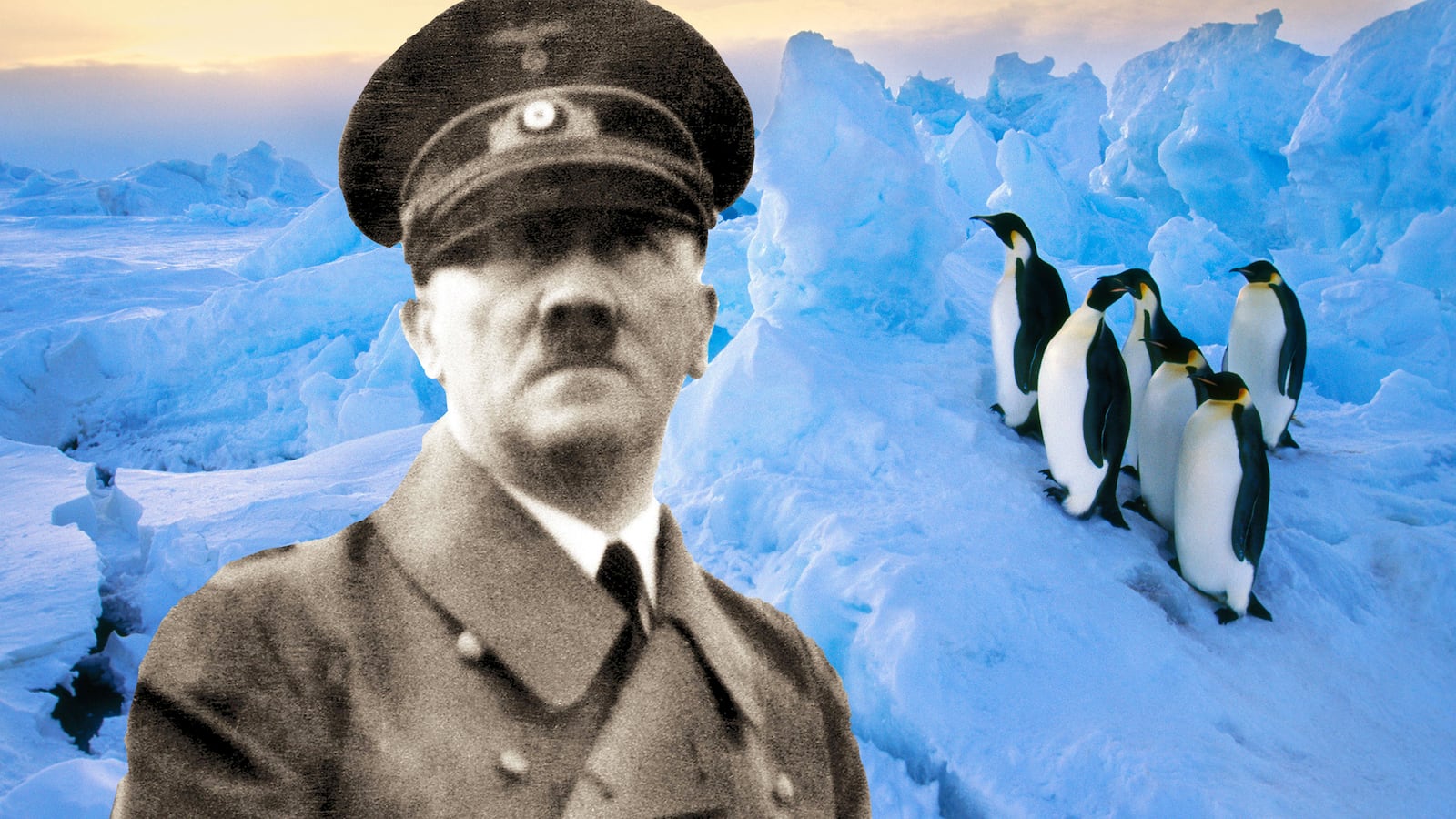Adolf Hitler and his wife, Eva Braun, committed suicide 70 years ago—or so they’d like us to believe.
Of all the Nazi conspiracy theories (buried gold sunken in Austrian lakes; jungle hideaways; U-boats filled with treasure off the coast of New Zealand), the most pervasive and indefatigable legend is that the fascist lovebirds survived the war and lived the rest of their lives in peaceful South American retirement.
The origins of these rumors lie in the fact that, though scholars agree Hitler and Braun carried out a suicide pact in an underground bunker, their remains were never publicly and formally identified. If they had made a daring escape as Berlin fell, say, the next stop would have been to Latin America, which was rolling out the red carpet for fleeing Nazis.
These fictions needed almost no time to marinate. They were spurred on by top officials in both the Nazi and Allied forces, and spread virulently in the West’s postwar confusion. “Nazi Envoy Says Hitler Still Alive,” the Associated Press blasted in 1945, with two quotes from a German diplomat promising the leader’s imminent return. Such assertions and sightings were so pervasive that the Federal Bureau of Investigation began actively looking into them.
Last year, the FBI declassified more than 700 pages of tips and investigations into the possibility that Hitler survived the war. Included in the trove were hundreds of typed and handwritten notes to the FBI, government memos attempting to verify the claims, and J. Edgar Hoover’s replies.
“According to [retracted], he was one of the four men who met HITLER and his party when they landed from two submarines in Argentina approximately two and one-half weeks after the fall of Berlin,” one report said, conveying descriptions of the heavily guarded ranch where Hitler, who had shaved off his mustache, was supposedly hiding out.
Another person swore Hitler had taken to hiding in plain sight and was residing in Manhattan, the ideal city for anonymity. A Maryland resident was convinced the two had shared a table at lunch in 1946 (“looked like he had been in confinement for sometime”). Another informant claimed Hitler was being treated in Spain for a “nervous condition.”
And then there’s the bold report that included a letter, translated from German and postmarked with German stamps, which was supposedly from Hitler himself. “[When] I was informed that my body and that of my wife had been covered with naptha and burred [sic] in the Chancellory [sic] garden. I could not help smiling for at this we were many kilometers south west of Berlin on our air journey to Argentina,” the fraud Führer boasted. (The man who turned this letter in was dubbed by the FBI “a psychopathic case.”)
But other tips were apparently worthy of follow-up. “His letter is coherent and it is not known whether or not he is a psychopathic,” an evaluation of another epistle reads.
The FBI trove ends in 1947, but the theories were only just getting started. Seventy years after the war’s end, dozens of historians, journalists, documentarians, and other conspiracy-inclined hobbyists are still peddling their wares as Hitler hunters. Like a mustachioed Carmen Sandiego, Hitler candidates have been popping up across the globe for years. Then, with a simple overlay of the signature facial hair and comb-over, or with some clever aging tricks, the believers declare a match. The theories range in delusional intensity—one claims Hitler was hidden in an Antarctic base—but the idea of a South American retirement remains the most popular.
Many Nazis did flee into the welcoming arms of South America after the war. Argentina, in particular, offered a safe haven, and rumors abounded that the highest levels of Nazi leadership had made a successful escape there. Most famously, Adolf Eichmann and Josef Mengele were granted refuge by Juan Peron, Argentina’s president at the time, who dispatched rescue voyages to Europe after Germany fell to retrieve the war’s losers from capture.
“[A]rgentina is teeming with unmolested Nazi war criminals,” journalist Johannes Steel wrote in a 1945 investigation.
No matter how absurd, theories of Hitler’s survival rarely fail to make international headlines. In 2014, the British tabloid Express proffered a grainy, virtually face-less photo of an older Caucasian man with the headline, “The INCREDIBLE picture that ‘proves’ Adolf Hitler lived to 95 with his Brazilian lover.” Citing a new book called His Life and His Death by author Simoni Renee Guerreiro Dias, the article outlines the argument that the Führer spent his last years in a small town in Brazil, going by the name Adolf Leipzig.
Last year also gave us Hitler in Argentina, which promised to “change the history you were taught in 5th grade.” It was the second book about Hitler’s certain survival by author Harry Cooper, who is classified as a neo-Nazi by watchdogs at the Southern Poverty Law Center.
Four years earlier, there was Grey Wolf: The Escape of Adolf Hitler. Two British journalists made similar claims about Hitler’s escape, alleging that he settled in Patagonia and fathered two children with Braun. When a local journalist claimed they had stolen his theory, it pitted the three in a Hitler survivalist-off.
Since the 1960s, the Russians have claimed that bones they extracted from the Eagle’s Nest after the war were Hitler’s. They took samples and then reportedly burned the rest of the corpses. The original jawbone they recovered apparently matched the records of Hitler’s dentist, the investigators said. But in 2009, DNA tests on what was thought to be Hitler’s skull turned out to belong to a younger woman.
Even those who believe Hitler survived the war’s end concede he must be dead today—unless the fountain of youth also turned up in his jungle hideaway. But new theories of cross-ocean Nazi infiltration are robust as ever. In March, Argentinian archaeologists revealed they were investigating claims that newly-discovered buildings had been used as Nazi bunkers. But a closer look found that the stories were blown out of proportion, blowing the lid off a Nazi hideout. “That was just speculation on my part,” the lead investigator told the Guardian after dozens of articles ran with the claims. “The press picked it up and magnified it.”






